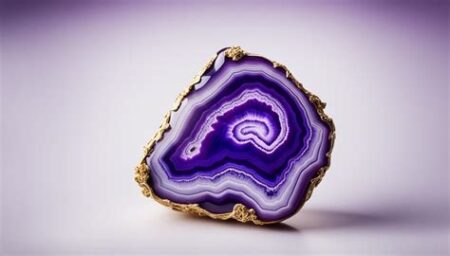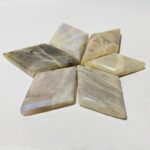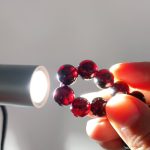In the realm of gemstones, there exists a captivating category of crystals that possess the extraordinary ability to glow, illuminating their surroundings with ethereal radiance. These luminescent wonders, known as phosphorescent or fluorescent crystals, have captivated the imagination of scientists, artists, and collectors alike for centuries. Their unique properties have led to a fascinating history of applications, from medical diagnostics to artistic masterpieces.

Fluorescence is the phenomenon that occurs when a substance absorbs energy, such as ultraviolet light, and then releases it as visible light. In phosphorescent crystals, this process continues for a longer duration, emitting light even after the source of excitation has been removed. The glow persists for varying periods, ranging from seconds to hours or even days.
Phosphorescence, a special case of fluorescence, is characterized by a sustained glow that persists long after the excitation source has been removed. This is due to the presence of metastable states within the crystal structure, which trap the absorbed energy and release it gradually over time. The duration of phosphorescence depends on the type of crystal and its structural defects, with some materials exhibiting afterglows lasting for several hours or even days.
The luminescent properties of crystals are primarily determined by their composition and crystalline structure. The transition metal ions, lanthanide ions, and organic compounds play a crucial role in the absorption and emission of light in these materials.
The unique properties of luminescent crystals have found applications across a wide range of fields:
1. Medical Diagnostics: Luminescent crystals are used in bioimaging techniques to visualize biological processes in real-time. They act as contrast agents, enhancing the visibility of specific tissues or cells and enabling precise diagnosis and treatment planning.
2. Solar Energy Conversion: Luminescent crystals have the potential to improve the efficiency of solar cells by capturing and converting unused light wavelengths into electricity. Research efforts are underway to develop new materials for this application.
3. Sensors and Displays: The luminescence properties of crystals can be harnessed to create highly sensitive sensors for detecting various substances, such as gases or chemicals. They are also used in display technologies, including electroluminescent displays (ELDs) and organic light-emitting diodes (OLEDs).
4. Artistic Applications: Luminescent crystals have inspired artists and designers to create mesmerizing artworks that glow under UV light or in the dark. From sculptures and paintings to jewelry and textiles, these materials add a touch of ethereal beauty to creations.
| Type | Example | Color of Luminescence | Examples of Applications |
|---|---|---|---|
| Phosphors | Zinc sulfide (ZnS) | Green, blue, red | Cathode ray tubes (CRTs), fluorescent bulbs |
| Fluorescent dyes | Rhodamine B | Pink, red | Microscopy, flow cytometry |
| Quantum dots | Cadmium selenide (CdSe) | Tunable (depending on size) | Biomedical imaging, displays |
| Thermoluminescent materials | Lithium fluoride (LiF) | Blue, green | Radiation dosimetry, medical imaging |
| Type | Duration | Description |
|---|---|---|
| Fluorescence | Seconds to minutes | Emission of light ceases shortly after excitation is removed |
| Phosphorescence | Minutes to hours or days | Emission of light persists for an extended period after excitation is removed |
| Year | Discovery | Scientist |
|---|---|---|
| 1603 | Phosphorescence in diamonds | Vincenzo Cascariolo |
| 1852 | Fluorescence in quinine | Sir George Stokes |
| 1938 | Luminescent organic dyes | Heinrich Otto Wieland |
| 1951 | Electroluminescence in gallium arsenide (GaAs) | Kurt Lehovec and Carl Accardo |
| Advantage | Disadvantage |
|---|---|
| High efficiency | Limited wavelength range of emission |
| Long-lasting glow (phosphorescent crystals) | Toxicity of some materials |
| Versatility in applications | Environmental concerns |
| Non-radioactive (most materials) | Potential for degradation over time |
- Maximize surface area: Exposing more of the crystal’s surface to light increases the number of molecules that can absorb and emit light.
- Choose high-purity crystals: Impurities can interfere with the luminescence process, reducing the intensity and duration of the glow.
- Use appropriate excitation wavelengths: The wavelength of light used for excitation should match the absorption spectrum of the crystal.
- Shield from UV radiation: Prolonged exposure to UV light can damage the crystal structure and reduce its luminescence properties.
- Store in dark conditions: Protect luminescent crystals from exposure to ambient light to preserve their glow for longer periods.
Materials:
- Glow-in-the-dark pigment powder
- Resin or glue
- Mixing cups and stirrers
- Mold or container
- Gloves
Steps:
- Prepare the resin or glue: Follow the manufacturer’s instructions to mix the resin or glue in the desired ratio.
- Add the glow-in-the-dark powder: Gradually incorporate the glow-in-the-dark pigment powder into the resin or glue, mixing thoroughly to achieve a uniform consistency.
- Pour into the mold: Transfer the mixture into the desired mold or container and ensure that it fills all the corners and crevices.
- Cure the resin or glue: Allow the resin or glue to cure as per the manufacturer’s specifications. This may take several hours or days, depending on the material.
- Enjoy the glowing creation: Once the resin or glue has fully cured, expose the creation to light for a few minutes to activate the glow-in-the-dark pigment. The glow will persist for hours or days after the light source is removed.
Crystals that glow are remarkable materials that have captivated scientists, artists, and collectors alike. Their unique luminescent properties have led to a fascinating history of applications, from medical diagnostics to artistic masterpieces. As research continues, we can expect to see even more innovative uses for these glowing wonders, unlocking new possibilities in various fields.




























